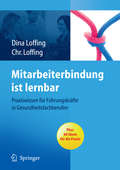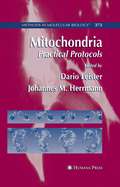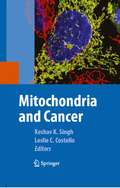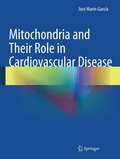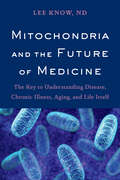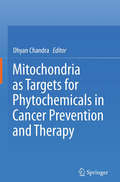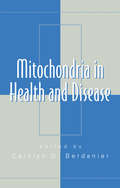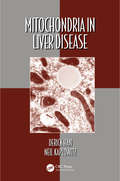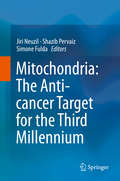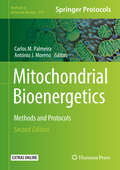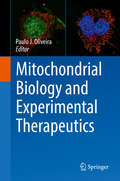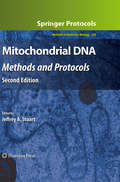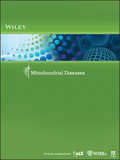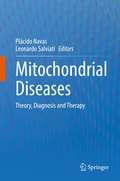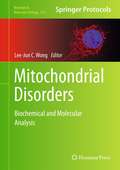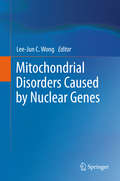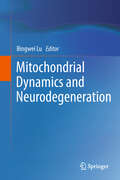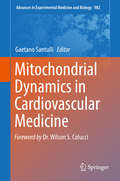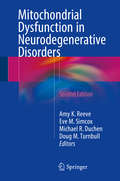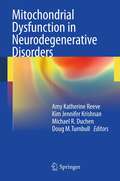- Table View
- List View
Mit Bewegung und Geselligkeit Demenz vorbeugen: Wissenswertes über wichtige Schutzfaktoren fürs Gehirn
by Helga Schloffer Ernestine LeutgebDemenzprävention ist in aller Munde. Von allen Seiten werden wir heute mit dem Begriff ‚geistige Aktivierung‘ bestürmt. Dabei sehen wir diesen meist viel zu eng und stürzen uns etwa auf das Erlernen einer Fremdsprache oder anderes, was unser Gedächtnis isoliert trainiert. Wir vergessen dabei aber auf das "symphonische" Ganze! Zur „geistigen Aktivierung“ gehört vieles – wie etwa das Koordinieren von Bewegung, die Orientierung im Raum, das Lesen der Mimik eines Mitmenschen. Geistige Aktivierung bedeutet also viel, viel mehr als nur „Gehirnjogging“&Co – und das lebenslang, nicht erst im hohen Alter! Dieses Sachbuch präsentiert sehr anschaulich Wissen rund um die bereits wissenschaftlich erwiesenen, aber trotzdem noch viel zu wenig beachteten Demenz-Risikofaktoren „Bewegungsmangel“ und „mangelnde Sozialkontakte“. Es zeigt auf, warum unser Gehirn ausreichend körperliche Bewegung und vielfältige Sozialkontakte braucht, um „fit“ zu bleiben, und warum man diese daher als „Schutzfaktoren“ verstehen kann. Denn ausreichend Bewegung und vielfältige Kontakte spielen eine lebenslange Rolle bei der Erhaltung unserer kognitiven Fähigkeiten und Funktionen! Das Buch richtet sich an alle Leser, die sich nicht passiv dem „Schicksal Demenz“ ergeben, sondern frühzeitig aktiv werden und „miteinander“ und „mobil“ der Demenz die Stirn bieten möchten.
Mit Erfolg zur Professur oder Dozentur: Ein Karriereratgeber mit über 180 Fragen und Antworten
by Dieter Frey Karl-Walter Jauch Mariella Theresa StockkampMit diesem Ratgeber bereiten Sie sich erfolgreich auf eine Professur vor und erkennen Stolpersteine und Hürden auf Ihrem Weg zur Professur. Klar, prägnant, gut strukturiert, unterhaltsam und lehrreich zugleich, basiert diese hilfreiche Lektüre fast 200 Fragen von Jungwissenschaftler*innen auf ihrem Weg zur Professur, die in über 25 Workshops gestellt wurden. Wissenschaftlich fundierte psychologische Exkurse, praktische Checklisten sowie Erfahrungsberichte namhafter Professor*innen runden den Inhalt ab. Dazu ist der Karriereratgeber digital angereichert und so können Sie Ihr neu erworbenes Wissen anhand von 50 Fragen und Antworten auf der Springer Nature Flashcard App jederzeit kondensiert abrufen. Zielgruppen: Das Buch richtet sich an Wissenschaftler*innen jeder Karrierestufe und begleitet Sie auf dem Weg zu Ihrer Traumstelle: Von der Entscheidung für eine wissenschaftliche Karriere bis zu Ihren ersten Tagen in der Professur. Im Mittelpunkt des Buchs steht der Bewerbungsprozess inklusive des Umgangs mit Berufungskommissionen. Zu den Autoren und der Autorin: Prof. Dr. Dieter Frey ist Leiter des LMU Center for Leadership and People Management und Mitglied der Bayrischen Akademie der Wissenschaften. Prof. Dr. Dr. hc Karl-Walter Jauch ist Ärztlicher Direktor und Vorsitzender des Vorstands am Klinikum der Universität München. Mariella Theresa Stockkamp, M.Sc. Psych., ist wissenschaftliche Mitarbeiterin am LMU Center for Leadership and People Management.
Mitarbeiterbindung ist lernbar
by Dina Loffing Christian LoffingNicht fesseln - binden! Wie können Pflegende trotz Arbeitsbelastung und Änderungen im Gesundheitssystem langfristig als Mitarbeiter gehalten werden? Welche Faktoren spielen eine Rolle, damit Mitarbeiter im Unternehmen bleiben - bzw. das Unternehmen verlassen möchten? Welche Steuerungsinstrumente gibt es? Ein Buch für Führungskräfte in der Pflege, das Ihnen praxisnahe Anleitungen, Strategien und Unterstützung bei der Personalbindung vermittelt: Theoretische Grundlagen der Personalbindung, praktischer Teil mit Handlungsstrategien für Krankenhäuser, Pflegeeinrichtungen und Ambulante Pflegedienste, u.a. best-practice-Personalbindungsstrategien, Instrumente, Checklisten, Formulare etc.
Mitarbeitermotivation ist lernbar
by Andrea Kerres Peter Bechtel Detlef FriedrichMotivierte Mitarbeiter entscheiden über den Erfolg eines Unternehmens. Dies gilt in besonderem Maße für Einrichtungen im Gesundheitswesen, denn Patienten wissen engagierte Zuwendung besonders zu schätzen. Das Handbuch richtet sich an Führungskräfte des mittleren Pflegemanagements in der stationären und ambulanten Kranken- und Altenpflege. Die Autoren erläutern Strategien zur Mitarbeiterführung und -motivation. Dabei vermitteln sie einerseits die theoretischen Grundlagen und geben Lesern andererseits konkrete Instrumente an die Hand.
Mitigating Shipping Emissions in European Ports: Social and Environmental Benefits (SpringerBriefs in Applied Sciences and Technology)
by Constantin Zopounidis Alexandra Maragkogianni Spiros PapaefthimiouThe book quantifies the impact of in-port ships’ greenhouse gas emissions and air pollution in adjacent cities, and evaluates the feasibility of implementing shore-side electricity facilities in Europe to reduce the unwanted social and environmental effects of ships at berth. The book also discusses the potential of future “green” ports and the use of shore side electricity as a means of achieving them. Individual chapters focus on the economic and social costs of in-port ships’ emissions by illustrating current environmental policies to mitigate air emissions and the available abatement measures for in-port emissions. It also discusses the external cost of vessel emissions in ports as well as the impacts on air quality and human health. Examining the expected barriers to the implementation of shore- side electricity facilities, it proposes policies to accelerate the implementation of relevant mitigation measures.
Mitigating the Nutritional Impacts of the Global Food Price Crisis: Workshop Summary
by Institute of Medicine of the National AcademiesIn 2007 and 2008, the world witnessed a dramatic increase in food prices. The global financial crisis that began in 2008 compounded the burden of high food prices, exacerbating the problems of hunger and malnutrition in developing countries. The tandem food price and economic crises struck amidst the massive, chronic problem of hunger and undernutrition in developing countries. National governments and international actors have taken a variety of steps to mitigate the negative effects of increased food prices on particular groups. The recent abrupt increase in food prices, in tandem with the current global economic crisis, threatens progress already made in these areas, and could inhibit future efforts. The Institute of Medicine held a workshop, summarized in this volume, to describe the dynamic technological, agricultural, and economic issues contributing to the food price increases of 2007 and 2008 and their impacts on health and nutrition in resource-poor regions. The compounding effects of the current global economic downturn on nutrition motivated additional discussions on these dual crises, their impacts on the nutritional status of vulnerable populations, and opportunities to mitigate their negative nutritional effects.
Mitochondria
by Dario Leister Johannes M. HerrmannThis book offers a broad collection of methods for studying the molecular biology, function, and features of mitochondria. In the past decade, mitochondrial research has elucidated the important influence of mitochondrial processes on integral cell processes. This practical guide presents a wide spectrum of mitochondrial methods, each written by specialists with solid experience and intended for implementation by novice and expert researchers alike.
Mitochondria and Cancer
by Keshav Singh Leslie CostelloThe book begins with a general overview of Warburg Hypothesis, mitochondrial structure and function, and then outline more specifically the metabolic and molecular alterations in mitochondria that are associated with human cancer and their clinical implications. An emphasis is also placed on mtDNA mutations and their potential role in carcinogenesis. The potential use of mitochondria as biomarkers for early detection of cancer, or as unique cellular targets for novel and selective anti-cancer agents will also be discussed.
Mitochondria and Their Role in Cardiovascular Disease
by José Marín-GarcíaOver the past two decades, due to dramatic advances in molecular and cell biology, biochemistry, and genetics, our view on mitochondria as a relatively static cellular powerhouse has changed radically. We now know that these organelles play a critical role in the normal and in the damaged heart. Written by Dr. José Marín-García, Director of the Molecular Cardiology and Neuromuscular Institute, Mitochondria and Their Role in Cardiovascular Disease brings readers up- to-date on the many significant advances in the field of mitochondrial cardiovascular medicine. The book begins with a general introduction to mitochondria, followed by laboratory methods to study the structure and function of the organelle, regulation of replication and biogenesis, and the mechanisms and functional consequences of mitophagia and mitochondrial dynamics. Subsequent chapters deal with mitochondrial oxidative stress and the role that the organelle plays in cell signaling and cell death. Discussions will be undertaken on the biochemistry of mitochondrial cell signaling, including the nature of the proteins engaged in these processes, many of them only recently discovered. Later chapters examine the role of mitochondria and mitochondrial abnormalities in cardiovascular diseases, including their diagnosis, therapeutic options currently available, animal models of mitochondrial disease, and new frontiers in mitochondria cardiovascular medicine, including areas of research that are relatively new or developing, such as proteomics, next generation sequencing, and systems biology.
Mitochondria and the Future of Medicine: The Key to Understanding Disease, Chronic Illness, Aging, and Life Itself
by Lee Know&“From infertility to aging to cancer and neurological disease, Dr. Lee Know will teach you that mitochondria play a central role in much that we care about in health and disease.&”—Stephanie Seneff, senior research scientist, MIT and author of Toxic Legacy With information for patients and practitioners on optimizing mitochondrial function for greater health and longevityWhy do we age? Why does cancer develop? What&’s the connection between heart failure and Alzheimer&’s disease, or infertility and hearing loss? Can we extend lifespan, and if so, how? What is the Exercise Paradox? Why do antioxidant supplements sometimes do more harm than good? Many will be amazed to learn that all these questions, and many more, can be answered by a single point of discussion: mitochondria and bioenergetics.In Mitochondria and the Future of Medicine, Naturopathic Doctor Lee Know tells the epic story of mitochondria, the widely misunderstood and often-overlooked powerhouses of our cells. The legendary saga began over two billion years ago, when one bacterium entered another without being digested, which would evolve to create the first mitochondrion. Since then, for life to exist beyond single-celled bacteria, it&’s the mitochondria that have been responsible for this life-giving energy. By understanding how our mitochondria work, in fact, it is possible to add years to our lives, and life to our years.Current research, however, has revealed a dark side: many seemingly disconnected degenerative diseases have tangled roots in dysfunctional mitochondria. However, modern research has also endowed us with the knowledge on how to optimize its function, which is of critical importance to our health and longevity.Dr. Know offers cutting-edge information on supplementation and lifestyle changes for mitochondrial optimization and how to implement their use successfully, including:CoQ10D-RiboseCannabinoidsKetogenic dietary therapyand more!Mitochondria and the Future of Medicine is an invaluable resource for practitioners interested in mitochondrial medicine and the true roots of chronic illness and disease, as well as anyone interested in optimizing their health.&“Dr. Lee Know does a brilliant job shedding light on this once ignored organelle and shows us how to care for our most important metabolic system.&”—Dr. Nasha Winters, co-author of The Metabolic Approach to Cancer
Mitochondria as Targets for Phytochemicals in Cancer Prevention and Therapy
by Dhyan ChandraThis book highlights the importance of phytochemicals and mitochondria in cancer prevention and therapy. Recent scientific discoveries have identified that naturally occurring biologically active compounds (i. e. phytochemicals) target multiple steps of tumorigenesis leading to the inhibition or delay in cancer progression. Mitochondria, organelles within a cell, are a critical target for phytochemicals in regulating the initiation, promotion, and progression of cancer. The book is divided into three parts to better communicate the important findings related to phytochemicals and mitochondria in cancer research. The first part describes updates on environmental and genetic factors causing cancer initiation and progression, the role of mitochondria function in regulating the process of tumorigenesis, and the role of mitochondria in regulating cell death such as apoptosis, autophagy, and necroptosis. The second part focuses on the elucidation of key target proteins that could be exploited for cancer prevention, an the role of phytochemicals in cancer prevention, updates on basic research related to phytochemicals action critical for cancer prevention, and updates on translational knowledge on cancer prevention by phytochemicals. The third part provides updates on phytochemicals targeting mitochondria for cancer therapy, an overview of action of phytochemicals on cancer stem cells, updates on the role of microRNA in phytochemicals-based therapy of cancer, and updates on phytochemicals-based translation research on therapy for metastatic cancer.
Mitochondria in Health and Disease
by Carolyn D. BerdanierIt was once assumed that mitochondrial diseases were rare and that few people were affected. As knowledge has grown about these organelles and their function, it became clear that mitochondrial malfunction could be linked to several chronic diseases. Diabetes has been associated with DNA mutation and can cause mutation itself. This text discusses f
Mitochondria in Liver Disease
by DERICK HAN NEIL KAPLOWITZ" excellent, well-organized, and timely."-Lester Packer and Enrique Cardenas, University of Southern California, Los Angeles, from the Series PrefaceThe liver is a vital organ that is responsible for a wide range of functions, most of which are essential for survival. The multitude of functions the liver performs makes it vulnerable to a wide range
Mitochondria: The Anti- cancer Target for the Third Millennium
by Jiri Neuzil Shazib Pervaiz Simone FuldaThis book will be focused on mitochondria as very promising targets for anti-cancer drugs, yet to be fully exploited. It will contain chapters focused on aspects of basic research as well as on clinical relevance, which will be written by specialists in the field. That the role of mitochondria in human pathologies goes beyond the neoplastic diseases will be documented by a chapter of the role of mitochondria in Friedreich's ataxia.
Mitochondrial Bioenergetics: Methods And Protocols (Methods in Molecular Biology #810)
by Carlos M. Palmeira António J. MorenoThis second edition volume expands on the previous edition with chapters discussing the latest developments and research initiatives in mitochondrial functions. The chapters in this book explore topics such as high-resolution fluorespirometry and OXPHOS protocols in human cells, analysis of mitochondrial oxygen consumption, mitochondrial bioenergetics, and mitochondrial dynamics in mammalian cells. Written in the highly successful Methods in Molecular Biology series format, chapters include introductions to their respective topics, lists of the necessary materials and reagents, step-by-step, readily reproducible laboratory protocols, and tips on troubleshooting and avoiding known pitfalls.Cutting-edge and practical, Mitochondrial Bioenergetics: Methods and Protocols, Second Edition is a valuable resource for students, and practitioners in the pharmaceutical sciences, environmental sciences, and mitochondrial genetics industries.
Mitochondrial Biology and Experimental Therapeutics
by Paulo J. OliveiraThis book addresses the therapeutic strategies to target mitochondrial metabolism in diseases where the function of that organelle is compromised, and it discusses the effective strategies used to create mitochondrial-targeted agents that can become commercially available drug delivery platforms. The consistent growth of research focused in understanding the multifaceted role of mitochondria in cellular metabolism, controlling pathways related with cell death, and ionic/redox regulation has extended the research of mitochondrial chemical-biological interactions to include various pharmacological and toxicological applications. Not only does the book extensively cover basic mitochondrial physiology, but it also links the molecular interactions within these pathways to a variety of diseases. It is one of the first books to combine state-of-the-art reviews regarding basic mitochondrial biology, the role of mitochondrial alterations in different diseases, and the importance of that organelle as a target for pharmacological and non-pharmacological interventions to improve human health. The different chapters highlight the chemical-biological linkages of the mitochondria in context with drug development and clinical applications.
Mitochondrial DNA
by Jeffrey A StuartSince the publication of the first edition, the number of unique heritable mtDNA mutations recognized as being associated with bioenergetic dysfunction, cell death and disease has grown. Likewise, our understanding of the basic biology of somatic mtDNA mutations continues to improve. In Mitochondrial DNA: Methods and Protocols, Second Edition, specialists from eight countries share their expertise, providing detailed protocols for studying many aspects of mtDNA. The volume is divided into three sections, which cover the transduction of information from mtDNA to functionally active respiratory complexes, mitochondrial reactive oxygen species (ROS) production as well as mtDNA damage and its repair, and the identification and quantification of heteroplasmic mtDNA mutations. Written in the highly successful Methods in Molecular BiologyTM series format, chapters include introductions to their respective topics, lists of the necessary materials and reagents, step-by-step, readily reproducible laboratory protocols, and notes sections, highlighting tips on troubleshooting and avoiding known pitfalls. Comprehensive and authoritative, Mitrochondrial DNA: Methods and Protocols, Second Edition promises to aid researchers in further expanding our knowledge of this vital area of cell biology.
Mitochondrial Diseases (Life Science Research Fundamentals)
by WileyThis collection of reviews and protocols provides the reader with an introduction to the current state of knowledge on how various diseases are related to mitochondrial dysfunction. Mitochondria contain their own genome, a small, circular double-stranded DNA (mtDNA), and alterations in mtDNA may play an important role in the multistep carcinogenesis of at least some types of human cancer. In addition to mutations of mtDNA, many mitochondrial syndromes are due to abnormalities in nuclear genes related to oxidative phosphorylation (OXPHOS). Mitochondrial tRNA (MTT) gene mutations are an important cause of human morbidity and are associated with a wide range of pathology, from isolated organ?]specific diseases such as myopathy or hearing loss, to multisystem disorders with encephalopathy, gastrointestinal dysmotility, and life?]threatening cardiomyopathy. The relationship of the mitochondrion organelle to aging and longevity is also discussed. Laboratory protocols describe methodology to characterize mtDNA heteroplasmy by parallel sequencing. Each eukaryotic cell contains hundreds of mitochondria with hundreds of mitochondria genomes. Mutant and wild-type mtDNA may co-exist as heteroplasmy, and cause human disease. The purpose of this protocol is to simultaneously determine mtDNA sequence and quantify the heteroplasmic level. Another protocol describes procedures for obtaining tissue sections and cell material suitable for histological evaluation of OXPHOS activity and integrity and immunodetection of the complexes in tissue from patients suspected of mitochondrial disease. Emphasis lies on the diagnostic potential of these techniques to differentiate mtDNA from nuclear mutations. This e-book — a curated collection from eLS, WIREs, and Current Protocols — offers a fantastic introduction to the field of mitochondrial diseases for students or interdisciplinary collaborators.
Mitochondrial Diseases: Theory, Diagnosis and Therapy
by Plácido Navas Leonardo SalviatiMitochondrial diseases comprise a clinically and genetically heterogeneous group of rare disorders that may affect virtually any system of the body at any age. Due to their complexity, understanding and diagnosing these diseases requires a multidisciplinary approach.This book provides an update on the major features of human mitochondrial diseases: genetic bases, pathophysiology, diagnosis, and treatment, and of the new technologies involved in the diagnosis and on the characterization of patients. The 11 chapters examine the unique complex interactions between the mitochondrial and the nuclear genomes involved in the biogenesis and the regulation of the mitochondrial respiratory chain, and their relevance to human disease. We discuss the traditional biochemical and genetic approaches, as well as the new omic technologies, and the cellular and animal models used in mitochondrial research. The last chapter is dedicated to the current treatment options.Authors are worldwide experts in these fields and integrate expertise in both basic science and clinical research.This book is particularly important for both scientists and clinicians interested in the diagnosis and treatment of these diseases.
Mitochondrial Disorders
by Lee-Jun C. WongDue to the complexity of the mitochondrial system and the myriad genes involved in their function, the clinical manifestations of mitochondrial diseases are remarkably variable and heterogeneous. The laboratory and clinical methodologies used to evaluate dysfunction may vary widely, and thusly a systematic presentation of the numerous protocols that are applied to the assessment of these clinically and genetically heterogeneous disorders has proven to be essential. Mitochondrial Disorders: Biochemical and Molecular Analysis strives to fill this need with a collection of key protocols provided by leading experts in the field. Beginning with overviews of complexity of mitochondrial and nuclear genome disorders, the book continues with a section devoted to current biochemical protocols and a part focused on the DNA-based approaches used to identify molecular defects. Written in the highly successful Methods in Molecular BiologyTM series format, chapters contain introductions to their respective topics, lists of the necessary materials and reagents, step-by-step, readily reproducible laboratory protocols, and tips on troubleshooting and avoiding known pitfalls. Detailed and authoritative, Mitochondrial Disorders: Biochemical and Molecular Analysis serves as a vital guide to researchers seeking to understand this incredibly complicated type of breakdown in cellular biology.
Mitochondrial Disorders Caused by Nuclear Genes
by Lee-Jun C. WongMitochondrial cytopathies are mutations in the inherited maternal mitochondrial genome, or the nuclear DNA-mutation. Mitochondrial respiratory chain disorders (RCD) are a group of genetically and clinically heterogeneous diseases, due to the fact that protein components of the respiratory chain are encoded by both mitochondrial and nuclear genomes and are essential in all cells. In addition, the biogenesis, structure and function of mitochondria, including DNA replication, transcription, and translation, all require nuclear encoded genes. Since mitochondria are present in every cell, every tissue, mitochondrial disorder usually affects multiple organs.
Mitochondrial Dynamics and Neurodegeneration
by Bingwei LuMitochondria are essential organelles in eukaryotic cells that control such diverse processes as energy metabolism, calcium buffering, and cell death. Recent studies have revealed that changes in mitochondrial morphology by fission and fusion, a process known as mitochondrial dynamics, is particularly important for neuronal function and survival. Defects in this process are commonly found in neurodegenerative diseases, offering a new paradigm for investigating mechanisms of neurodegeneration. To provide researchers working on neurodegenerative diseases and mitochondria with updated information on this rapidly progressing field, we have invited experts in the field to critically review recent progresses and identify future research directions. The topics include genetics of mitochondrial dynamics, mitochondrial dynamics and bioenergetics, autophagy, apoptosis, and axonal transport, and its role in neurological diseases, including Alzheimer's, Parkinson's, and Huntington's diseases.
Mitochondrial Dynamics in Cardiovascular Medicine
by Gaetano SantulliThis text covers the basic principles of mitochondrial dynamics in cardiovascular medicine, with particular emphasis on their functional roles in physiology and disease. The book will include articles pertaining to mitochondrial fitness on a global basis, providing therefore an update on the progress made in several aspects in the field. Thus, it will assist scientists and clinicians alike in furthering basic and translational research. Organized in sections focusing on: basic science, mitochondrial dysfunction in cardiac disorders, in vascular disorders, in metabolic disorders, in kidney disease, therapeutic challenges and options, this essential volume fills imperative gaps in understanding and potentially treating several cardiovascular disorders.
Mitochondrial Dysfunction in Neurodegenerative Disorders
by Michael R. Duchen Amy K. Reeve Eve M. Simcox Doug M. TurnbullThis second edition brings together up-to-date contributionsfrom leaders in the field internationally on the various ways in whichmitochondrial dysfunction contributes to the pathogenesis of neurodegenerativediseases, including Parkinson's disease, Alzheimer's disease and multiplesclerosis. The reader is guided through the basic functions of mitochondria andthe mechanisms that lead to their dysfunction, and on to the consequences ofthis dysfunction for neuronal function before finishing with the modelling ofthese disorders and discussion of new potential therapeutic targets. Additional chapters have been added to the book to reflectadvances in the field and there are many new contributors and topics, includinghow mitochondria are degraded and the interaction of the mitochondria withpathologically relevant proteins. Mitochondrial Dysfunction in Neurodegenerative Disordersprovides an accessible, authoritative guide to this important area forneurologists; research and clinical neuroscientists; neuropathologists; andresidents with an interest in clinical research.
Mitochondrial Dysfunction in Neurodegenerative Disorders
by Kim Jennifer Krishnan Doug M Turnbull Amy Katherine Reeve Michael R. DuchenAs age related diseases increase in prevalence and impact more significantly on medical resources it is imperative to understand these diseases and the mechanisms behind their progression. New research has stimulated a growing interest in mitochondrial involvement in neurodegenerative disorders such as Parkinson's disease, Alzheimer's disease and multiple sclerosis and the mechanisms which lead from mitochondrial dysfunction to neurodegeneration. Mitochondrial Dysfunction in Neurodegenerative Disorders brings together contributions from leaders in the field internationally on the various ways in which mitochondrial dysfunction contributes to the pathogenesis of these diseases, guiding the reader through the basic functions of mitochondria and the mechanisms that lead to their dysfunction, to the consequences of this dysfunction on neuronal function before finishing with the modelling of these disorders and discussion of new potential therapeutic targets. Mitochondrial Dysfunction in Neurodegenerative Disorders provides an accessible, authoritative guide to this important area for neurologists; research and clinical neuroscientists; neuropathologists; and residents with an interest in clinical research.


